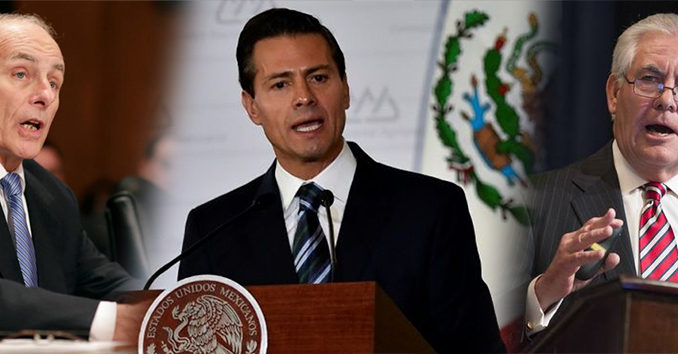
by Molly O’Toole
Despite the president’s threats, Mexico City also has leverage when it comes to immigration and border security.
The Mexican border police officer hung from the back of the truck rumbling through the streets of Tapachula, near the border with Guatemala, one hand on the overhead roll bar and the other on his AR-15 rifle. Made in the USA, he said. So was his bullet-proof vest. And much of his training.
His unit is meant to help migrants, but his gear underscored the close relationship — and direct assistance — that Mexican security forces have with their counterparts in the United States, a relationship that’s matured in recent years to reach unprecedented cooperation combating drugs, transnational crime and migration.
That’s the reality that Department of Homeland Security Secretary John Kelly and Secretary of State Rex Tillerson will confront in Mexico this week, as they make the hard sell to Mexican President Enrique Peña Nieto and other officials on President Donald Trump’s tough new immigration directives.
Released publicly on Tuesday, the new orders rescind most all of President Barack Obama’s orders and guidance on immigration, staking out a much tougher line on undocumented migrants in the United States. They make it easier for U.S. officials to deport huge numbers of immigrants simply for having entered illegally. They also expand “expedited removal” without a hearing for those caught within two years of entering and anywhere the U.S., a clear break with the Obama administration, which only used the practice for those apprehended within two weeks of entering and within 100 miles of the U.S. border. The directives would even deport foreign nationals to countries other than their own. (Read the orders here and here.)
“There’s a misperception that because the U.S. is much bigger and in many ways more powerful, that Mexico lacks leverage,” Chris Wilson, the deputy director of the Mexico Institute at the Woodrow Wilson International Center for Scholars, told Foreign Policy. “Right now Mexico is deporting more Central Americans than the U.S., so many would say Mexico is doing some of the United States’s dirty work … all of that — and Mexico has basically stated as much — is on the line if the cooperative framework of the relationship is lost.”
Under Obama, exceptions were made for immigrants brought to the United States as children and some of their parents. Despite reports of people under these programs being detained under the administration’s on-going crackdown, the White House says that for now, the new directives maintain that exception. Last week, Trump said he’d “show great heart” in determining the fate of some 750,000 offered work permits under the program known as DACA.
But the White House hasn’t helped allay fears. While saying immigrants who pose a threat to public safety are the priority for deportations, spokesman Sean Spicer noted Tuesday “everybody who is here illegally is subject to removal at any time.”
DHS insists its goal is not “mass deportation” of the estimated roughly 11 million undocumented immigrants in the United States. “We don’t need a sense of panic,” a DHS official said on a background call Tuesday to explain the new directives.
Trump has seriously strained U.S.-Mexico relations since before he took office, threatening trade wars, working on a border wall, and even talking of sending the U.S. military across the border to confront “bad hombres.” (Peña Nieto cancelled a trip to Washington last month.) On Tuesday, Mexico’s incoming ambassador to the United States said Trump’s treatment of Mexico is “unacceptable.”
It’s left to Kelly to do the difficult work of translating the new president’s bluster into policy guidance for the frontline border patrol agents who have to implement it — and the alarmed heads of state they need to make it work.
That’s especially important because the biggest immigration headache for the United States doesn’t originate in Mexico — but requires Mexico’s help to tackle.
Illegal crossings into the United States from Mexico have sunk to their lowest levels in four decades, and among Mexican immigrants, the flow has in fact reversed since 2009, at the tail end of the Great Recession. Rather, it’s the violence-ridden countries of the “Golden Triangle” — Guatemala, Honduras, and El Salvador — that have been the primary drivers of migration through Mexico to the United States in recent years, as seen in spikes of unaccompanied minors at the border. And it’s not just Central Americans. Global migration — from Haiti and Cuba to Cameroon and Somalia — has pushed more people to use the dangerous land route to the United States.
Under a grab bag of different programs, Washington has provided billions of dollars in assistance to Mexico and those Central American countries to stop their citizens from reaching the United States. Mexico has responded, dramatically stepping up its detentions and deportations, with removals doubling from 2013 to 2016, primarily of Central Americans. And more people are deciding to stay in Mexico and apply for refugee status there, rather than trying to cross into the United States. Trump’s latest orders call for auditing “all sources of direct or indirect” federal aid to Mexico, hinting at cuts.
But the Trump administration’s new rules on immigration enforcement could sour that relationship and paradoxically drive more immigration northward. The new rules could give Mexico more leverage to push back against Washington, especially if the recently-stepped up enforcement at Mexico’s southern border were scaled back, or if U.S. funding dried up.
Repatriation requires the cooperation of the country of origin — and active steps to ensure the migrants don’t simply turn around and try again, particularly if they are returned to areas close to the U.S. border. On Wednesday, DHS said, Kelly will observe a repatriation flight to Guatemala of recent deportees. (The cost of such flights from the United States — on average more than $8,000 an hour for charters — is borne entirely by American taxpayers.)
One new provision would enable Washington to deport undocumented migrants to the country from where they crossed the border. DHS confirmed to ProPublica that it is looking to send migrants who entered the United States from Mexico back there — regardless of whether or not they are Mexican citizens. The new directive said the U.S. government would save money and resources because officials would return migrants “to the foreign contiguous territory from which they arrived” to be detained there while they waited for their cases to be adjudicated, rather than on U.S. soil.
“If you want to make a claim for asylum or whatever we’ll hear your case but you are going to wait in Mexico,” a DHS official said, adding the details are still being worked out with the Mexican government.
Mexico, though, would have to agree to that, and it’s not at all clear it will want to hold thousands of immigrants as they await their proceedings with U.S. officials. Additionally, a 2001 Supreme Court ruling found that if a country of origin doesn’t agree to take a migrant back, he or she must be released from detention.
“If the United States starts sending non-Mexicans back to Mexico, Mexico doesn’t have to receive them,” Wilson said. “Just like the U.S. gets to determine who is admitted, so does Mexico.”
Kelly at least, though dealt a tough hand as an emissary for Trump policies that have sparked mass protests in Mexico, has substantial experience with security counterparts in the region thanks to his former leadership of U.S. Southern Command, which stretches from the Mexican border to the southern cone. He has spent time on both sides of Mexico’s northern and southern borders, and worked extensively with the governments of Guatemala, Honduras, and El Salvador.
That experience helped inform a more nuanced view of immigration than Trump has often espoused. But it remains to be seen how much of a tempering influence Kelly has on the president.
Officials said aides to former senator and current Attorney General Jeff Sessions, an immigration hardliner, drafted the latest implementation plan without input from career staffers at DHS, according to ProPublica. Kelly hinted at the Munich Security Conference last week he hadn’t gotten a chance to provide input on the rollout of Trump’s previous immigration executive orders, but would be doing so now.
Still, in his confirmation hearing before the Senate last month, Kelly praised the progress and importance of regional security forces to stanching the northward flow of migrants. In order to really stop drugs and people from reaching the U.S. border, he said the oft-touted “wall” should be built much farther south.
“Security of the border starts 1,500 miles south of the Rio Grande,” he said, “in the jungles of Latin America.”
Molly O’Toole is a senior reporter at Foreign Policy.



